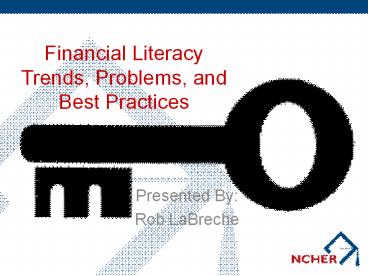Financial Literacy Trends, Problems, and Best Practices - PowerPoint PPT Presentation
1 / 30
Title:
Financial Literacy Trends, Problems, and Best Practices
Description:
Financial Literacy Trends, Problems, and Best Practices Presented By: Rob LaBreche What did we learn from our student survey? 12,000 original respondents filled out ... – PowerPoint PPT presentation
Number of Views:253
Avg rating:3.0/5.0
Title: Financial Literacy Trends, Problems, and Best Practices
1
Financial Literacy Trends, Problems, and Best
Practices
- Presented By
- Rob LaBreche
2
(No Transcript)
3
What did we learn from our student survey?
- 12,000 original respondents filled out one
section - 6,000 attempted several sections
- 4,095 filled out all sections
- Ages 18-76
- Median age 32
- Nearly 1/5 of respondents identified as being
unbanked - 31.2 were without a savings account
- Over 50 have a least ONE credit card
- 98 have student loans
4
Current Student Status
5
Educational Attainment
6
Types of Student Loans Borrowed
7
What is your current job search priority?
8
What caused you to drop out?
9
General Comments/Observations
- A significant portion of respondents indicated
that their institution did not provide the
guidance or direction they need to be successful - Students enrolled entirely in online programs
thought about dropping out and ultimately ended
up dropping out more than their traditional
campus counterparts
10
What keeps you in school/staying positive?
11
What do you want to know/understand about your
future?
12
Recorded Response
18-34 Years Young
35-64 Years Young
- Will/Already is Affecting Me
- Might Affect Me
- Wont Affect Me
- Unsure if it will Affect Me
46.3 10.9 32.7 10.2
47.5 8.3 27.5 15.8
Note Responses may not equal 100 due to rounding
13
Preference for Learning Tools
14
What motivates you to use iGrad?
15
Administrators were asked to rank a students
knowledge and their own knowledge of the
following areas
- Money Management
- Investing
- Financial Aid
- ID Theft
Scoring 4 Above Average 3 Average 2 Below
Average 1 Poor
Can you guess what the scores were?
16
What else did we learn from our Administrator
Survey?
17
Do you have a Financial Literacy task force?
- Not Sure,
- 11.5
18
Do you have a Financial Literacy strategy or
platform in place?
- Not Sure,
- 9.4
19
Who owns Financial Literacy on your campus?
- Academics/Faculty
All
Alumni
Bursar/Financial Services
Default Prevention
Financial Aid
Financial Literacy
FYE
Other
20
Is your Financial Literacy program mandatory?
- Not Sure,
- 8.4
21
Do you believe that Financial Literacy should be
mandatory?
- No
Yes, but only for borrowers
Yes, but students should be able to test out
71
Yes, mandatory for all
22
If you have a Financial Literacy program in
place, what percentage of the student population
is using it?
- Over 50,
- 16.2
31-50, 8.8
23
What is your budget for a Financial Literacy
program?
- gt 1.50/student,
- 7.70
Less than 1.50/student,11.10
24
Financial Literacy Best Practices
25
There is no singular or perfect operational model
for a campus financial literacy program
26
Institutional Action Plan
- Identify your advocates on campus and in the
community - Start a task force
- Involve students
- Know your students
- Start small, but choose engaging content and
delivery methods - Learn from other institutions
- Create a mission/goal statement and definition of
success
27
AND the most prevalent and successful models are
- Interactive Online Programs
- Classroom Based Programs
- Game Based Education
- Event Based Programs
- Individual Counseling
28
Research Will Unlock The Answers
- University of Arizona study
- Multi-year study on how young adults develop and
gain financial knowledge - Research is based on behavioral economics and
psychological aspects of decision making - Hope is that studys long-term results will
unlock about what causes people to spend, save,
take on debt, etc.
2. iGrad study
- Currently measuring impact of financial literacy
strategies with regard to lowering defaults and
increasing retention
29
5 6 Keys to a Successful Financial Literacy
Program(5 just wasnt enough!)
- Make is ACCESSIBLE
- Make it MANDATORY
- Get Buy-In from MULTIPLE DEPARTMENTS
- Make it RELEVANT
- Make it REPETITIVE
- MEASURE IT!!!
30
Questions/Discussion































